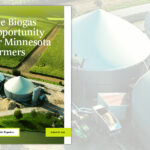
Ted Niblock
BioCycle November 2015
On September 25, 2015, the California Air Resources Board (CARB) “reinstated” the Low Carbon Fuel Standard (LCFS). The LCFS is a program designed to combat climate change by reducing the percentage of greenhouse gas emissions from vehicle travel in California through a system of tradeable credits and carbon footprint reduction requirements. Similar to the federal Renewable Fuels Standard, the LCFS requires sellers of gasoline and diesel to reduce the carbon footprint of the fuels that they sell, either by improving the footprint of the fuels themselves, or purchasing credits representing the production of lower carbon footprint fuels.
The LCFS ranks all vehicle fuels on a scale of carbon intensity. Fuel for compressed natural gas (CNG) vehicles created from biomethane, the type most often produced by anaerobic digesters, compares extremely favorably to fossil fuels — usually 80 to 90 percent less CO2, making each gallon equivalent of biogas-derived CNG quite valuable on the LCFS credit market under normal regulatory conditions. Unfortunately, the past few years have not been normal, as LCFS reduction targets have been held below the original regulatory schedule by pending litigation.
The original LCFS targets required gasoline sellers to reduce the carbon footprint of all fuel sold by 10 percent by 2020. The gradual increase was halted at one percent a few years ago, but the new regulations issued by CARB call for the target to still be achieved, with a steeper rate of reduction. The story of California’s virtuous environmental policies has often deserved the subtitle “no good deed goes unpunished,” and it has long since grown accustomed to seeing each new idea dragged into the horrid purgatory of litigation. In this case, CARB has refused to lose ground.
With the LCFS back on track, prices have risen and should continue to do so. According to reporting by the Oil Price Information Service (OPIC), when the target was low, prices for credits were low, falling to $20 to $25/metric ton of CO2 avoided (MT/CO2e). Since the lawsuit was resolved and new regulations were being developed, the market anticipated a return and prices have been rising. On Monday, November 2, as this column went to BioCycle, the price was $87.50.
As OPIC points out, the rising price of the credit actually affects the difference between fossil and biofuels in two ways. The price of the credit increases, but that price paid also must be priced into the cost of the fossil fuel. Put another way, when the gasoline seller buys the credit for $90, it also needs to recover that $90 by adding it to the price of gas. Therefore as truck fleet operators consider whether to switch to biomethane-derived renewable CNG (RCNG), they are both drawn towards renewable fuels by the value of credits to sell, and also pushed by rising fossil fuel costs, which result from the cost of those credits passed into diesel prices by the sellers of diesel.
Project Financing Benefit
So how does this manifest itself in the finances of your biogas project? According to a very thorough February 2015 study commissioned by the Natural Resources Defense Council, Union of Concerned Scientists, and the Environmental Defense Fund (together the key players in centrist, market-savvy environmental policy), it looks good.
The study provides prices per gallon equivalent for various alternative fuels, using a range of possible prices for LCFS from $50 to $150 MT/CO2e. As noted above, prices have already risen to nearly $90 in less than 45 days after the regulations came out. At $50, a gallon equivalent of biogas-derived CNG is worth $0.49, and at $150, it is worth about $1.48. In most cases, biogas to CNG projects can already compete with diesel prices, so this is an additional boost to project economics.
There are only a few examples of biomethane to RCNG currently in operation, so hopefully this restart of such an important program will bring more of these projects online. As usual, a lack of regulatory certainty has delayed investment, but the attitude of the capital markets is improving, as the program returns to full health and perceived risk goes down.
Ted Niblock develops biogas projects for NewAg Development.













